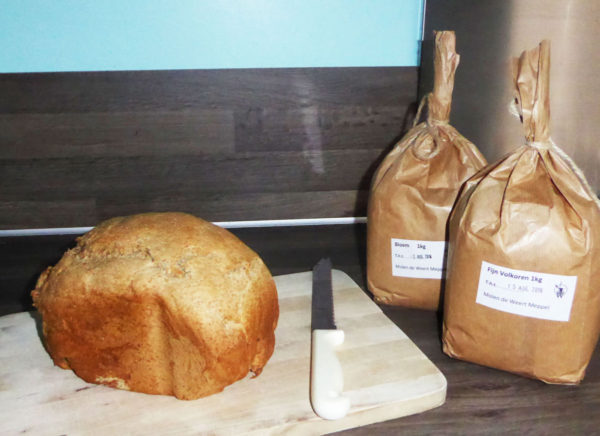There are many different types of flour available. Finding a good quality flour is the easiest way to improve your baking. Flour from Dutch supermarkets tends to be very processed, resulting in white, tasteless flour that is missing many of the natural enzymes.
At the start of the new year we bought a bread machine. After making a few loaves and trying a few different recipes I was so disappointed at the bread that came out of it that I was ready to send bread machine to the kringloop and forget the idea of fresh homemade bread. Then a friend suggested visiting the local windmill for our flour.
Visiting the windmill, we got to see them actually grinding down the wheat and packing it. The smell from the fresh flour was amazing, totally different from the flour you buy at supermarkets. Our local mill produces a few different types of flour, plain flour, wholemeal flour and spelt flour. They also sell gluten and yeast, and baking mixes for pancakes and cakes. The most surprising thing was that the prices were the same as buying flour from the supermarket, yet you get a much better quality product.
We are still experimenting with different bread recipes, and using a mix of flours in our baking, but so far, the results with fresh flour from the windmill are much better. So visit your local windmill, they also often can give advice on baking cakes and breads, and may even have recipe cards available.
If you don’t have a windmill anywhere near, try checking the flour section or speciality food section at your local supermarket. Some supermarkets (even big names like Jumbo and AH) will stock flour produced by windmills within the region.
See the table for a list of different types of flour and what they are called in Dutch.
| Protein | US | German | Italian | Netherlands |
| ~ 9% | pastry flour | 405 | 00 | zeeuwse bloem |
| ~ 11% | all-purpose flour | 550 | 0 | patentbloem |
| ~ 14% | high gluten flour | 812 | 1 | tarwebloem |
| ~ 15% | first clear flour | 1050 | 2 | gebuilde bloem |
| ~ 13% | whole wheat flour | 1700 | Farina integrale | volkorenmeel |
If you fancy trying to make some fresh bread here is the recipe I use.
Ingredients
- 10g salt
- 300g whole wheat flour (volkorenmeel)
- 200g all-purpose flour (patentbloem)
- 10 gram butter
- 10 gram sugar
- 7 gram gluten powder (glutenpoeder)
- 6 gram dried yeast (gist)
- 320 ml luke warm water.
Directions to make using a bread machine
Add all the ingredients in order to your bread machine trommel. Make sure the salt and yeast do not come into close contact as the salt can kill the yeast.
You can use either a regular programme or a speed programme. This recipe is for a 700g loaf, or there about, depending on your machines settings.
Directions to make by hand and in the oven
Dissolve the yeast in the water, add in the sugar and leave for a few minutes.
In a separate bowl mix together the wheat flour, all-purpose flour, salt and butter.
Make a well in the middle of the flour mix and pour in the yeast water and stir gently.
Knead the mixture for 10 to 15 minutes; the dough is ready when it is smooth and elastic.
Place the dough in a warm place (about 25 ⁰C) with a damp cloth over it and leave it for 1 hour to rise.
Flour your work surface and briskly knead the dough until all the air is gone.
Form the dough into a loaf shape and place on a greased baking sheet or loaf tin. Put in the oven on the lowest temperature setting to let the dough rise.
Remove the bread from the oven and increase the oven temperature to 200 ⁰C. When the oven reaches temperature, return the bread to the oven and bake for 40 minutes. The bread is ready when it sounds hollow when tapped.
Remove the bread from the oven and from the baking sheet to a wire rack to cool.
Hope you enjoy the smell of freshly baked bread wafting through your home; it does make a nice start to the weekend!
 +31 (0)50 367 71 97
+31 (0)50 367 71 97  info@connect-int.org
info@connect-int.org
